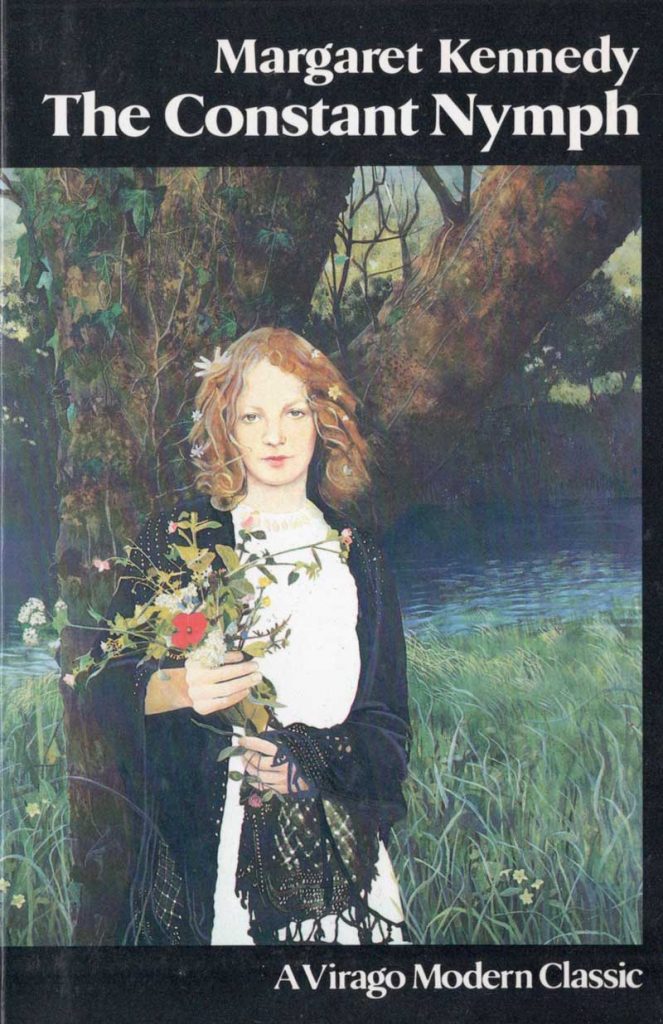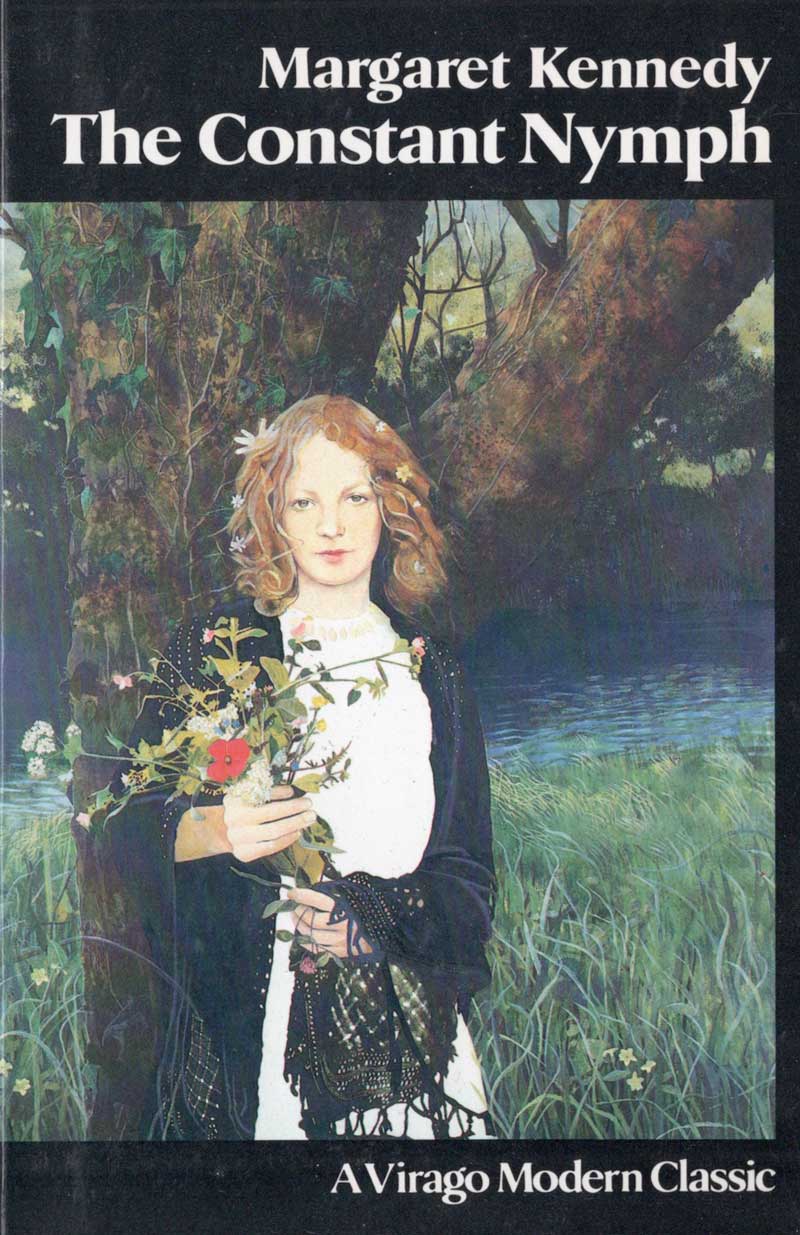
Margaret Kennedy’s 1924 novel The Constant Nymph was famous in its time, but sat mostly forgotten and had fallen out of print when it was republished by The Dial Press as part of their Virago line in 1984. Virago was dedicated to reviving forgotten novels by women authors, some have said regardless of the actual quality of the work, but in this case it seems that The Constant Nymph is genuinely a lost classic, a book whose relevance now seems to be finally due for recognition.
This relevance even seems to have been lost on the Virago editors. The blurb on the back of this edition calls this “one of the most popular romantic novels ever written”, a description which is immediately going to bring up that problematic word “problematic”, because the central romance in the book is between a man in his 30s and a fourteen year old girl. Yes, problematic.
Teresa Sanger is the daughter of Albert Sanger, who we’re told is a brilliant but under appreciated composer. He and his impressively large clan of children, wives, lovers, and hangers-on are encamped in the Austrian Alps, where their household is a bohemian paradise, an amiable anarchy of artists and free spirits, called throughout the novel Sanger’s Circus. Teresa, who is fourteen when the story begins, is in love with Lewis Dodd, also a composer and one of her fathers disciples. Dodd also has an attraction to the young Teresa.
The first part of ht novel takes place as Dodd is visiting to the Sanger household and its patriarch dies. Those children who are too young to care for themselves are dispersed, as part of which Teresa’s cousin Florence comes from England to fetch Teresa and some of her siblings to enroll them in a British boarding school. Dodd, struck by Folrence’s beauty, becomes enamored and the two impetuously marry, despite the fact that he is also obsessed with the young Teresa. The rest of the novel explores whether or not any of this was a good idea. Spoilers: mostly not.
The Constant Nymph was enormously popular when it was first published, adapted for the stage in 1926, for film in 1928, again for film in 1933, and again in 1943. The adaptations and critical reaction at the time seem to suggest that the popular reading of the novel was as a portrait of passionate artists and doomed love. The novel’s audience seemed committed to the idea that true love should transcend all boundaries. That there exists a certain type of great man, the true artist, for whom being held back by repressive society is the greatest tragedy, and that the normal rules of stuffy drawing rooms and formal concert halls should not apply to these men.
Which is where I really have to question what those people were reading. Because to me, it comes across as a subtle yet vicious satire of that bohemian license and the damage that it can do. These are not good people, they are not doing good things, and the book is clear about that.
Kennedy’s narrative voice constantly dips in and out of character’s perspectives and an omniscient voice. There’s a deftness to this which, while only occasionally providing direct commentary, nevertheless manages to allow most every character to come across poorly. There is what I think is a key passage near the end of the first section of the book, where Dodd is walking through the hills with the young Teresa.
He wondered anxiously, and for the first time, what was to become of her.
He Knew.
He had always known, and until to-night he had taken it for granted. She was barely two years younger than the sister whose history she would invariably repeat. Paulina, too, was fashioned for the same fate. Unbalanced, untaught, fatally warm-hearted, endowed with none of the stolid prudence which had protected the more fortunate Kate, they were both likely to set about the grimy business of life in much the same way. He knew what company they kept; lust, a blind devourer, a brutish, uncomprehending Moloch, haunted their insecure youth, claiming them as predestined victims.
What seems clear here is that that blind devourer, that uncomprehending Moloch, is Dodd himself. He is the one who will eventually break off his marriage, abscond to the continent with Teresa, and bring her story to a very unfortunate end. There’s nothing predestined about it, it’s just his self-absorption and wild sense of entitlement. He’s the one destroying lives here. Whether or not he’s doing it for the sake of art doesn’t really seem to matter all that much.
In The Constant Nymph, Kennedy seems to be criticizing the cult of the bohemian artist. The opening setting of the novel is the Austrian Alps evokes the setting of the final section of D.H. Lawrence’s Women in Love, which had been published only four years before. Lawrence is definitively on the side of the artist being unbound convention, and one would think atet if posed with the question of should you run off to Belgium with a severely underaged girl, Lawrence would respond Sure! Go for it! if he wasn’t so busy thinking about sweaty, naked men wrestling in front of the fireplace, no homo. Only it’s Lawrence’s view that has mostly won out in the past eight years.
Kennedy’s insight into the bohemian mystique is that, to function, it relies on exclusion. In the early chapters, there’s the character of Kiril Trigorin, a choreographer who has also taken up an invitation to visit Sanger in his mountain home, although it becomes soon obvious that he has misread the sincerity with which the invitation was offered. Dodd and the Sanger Circus are immediately dismissive and abusive of Trigorin, mostly on aesthetic grounds. He does not fit their idea of what one of them should be. But Kennedy also pauses the narrative to supply Trigorin with a sympathetic backstory, something no other character in the novel receives.
There’s a similar dynamic at work with Jacob Birnbaum, the only Jewish character in the novel, who marries Antonia Sanger, Teresa’s older sister. Yes, there is antisemitism in this book. The Sanger Circus has nicknamed Birnbaum “Ike”, an abbreviation of “Ikey Moses”, which was common antisemitic slur at the time. The Jewishness, suspected Jewishness, or association with Jews of any character in the novel is a point of ongoing commentary from multiple characters. But Birnbaum is also the most sympathetic character in the novel. He is kind, generous, and his marriage to Antonia seems to be the only happy relationship in the entire work.
It’s telling that the antisemitism only comes up when Kennedy dips her narrative voice into her characters heads, and I genuinely think she’s using it as a way to demonstrate what awful people they are. Florence, the embodiment of bourgeois propriety, is equally, if not more, vicious in her antisemitism than the Sanger clan. All of society, Kennedy seems to be saying, whether obsessed with proper etiquette and the right sized teacups or traipsing bohemian and barefoot through the alps, relies on deciding who the wrong kind of people are and keeping them out. And when you build a society around those structures of exclusion, it allows those who are the right kind of people tremendous license inside those structures. Like granting men sexual access to fourteen year old girls, because those men are great artists. You may have heard that one a time or two lately.
And that’s the fascinating thing. The Constant Nymph seems to be an almost perfect novel for this moment. But it seems that the subtle satire that is obvious to modern eyes was missed for three quarters of a century. There’s even a deep irony in the cover art of my Virago edition, a detail from Annie Ovenden’s painting Ophelia. Ovenden, along with her husband Graham Ovenden, was a founding member of the Brotherhood of Ruralists, a sort of painterly commune born in the English countryside in the 1970s, which had a Sanger Circus like atmosphere of freewheeling bohemianism, where children ran free and wild. In 2013, Graham Ovenden was convicted of six counts of indecent assault of minors, in incidents stretching from the 1975 to 1985. In a statement to the press, he defended himself by saying “I am a famous artist.”
The Constant Nymph sees the problem with famous artists. It sees that elevating certain men to a status above the rest of humanity creates situations for abuse, and a secondary class of people who find themselves taking pride in cleaning up after these men. It only took us nearly a century after the book was written to catch on to that. Dodd’s romance with Teresa is not a romance. It’s an insecure, vain man using his privilege to satisfy his ego at the cost of the health, happiness, and even lives, of the women around him. Teresa had already mostly outgrown her schoolgirl crush when Dodd abandons his wife for her, but Teresa also recognizes that she has no pleasant options in the situation. That this attack on destructive romanticism was mistaken for destructive romanticism when the book was first published is a devastating commentary on how deeply these ideas are embedded in the culture. This is a book that’s reputation deserves to be revived, and there should be some collective cult over the fact that it took us so long to hear what it has to say.
